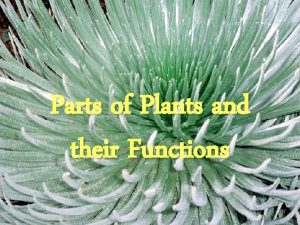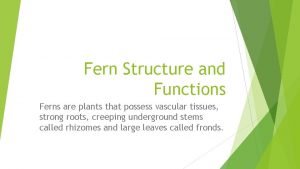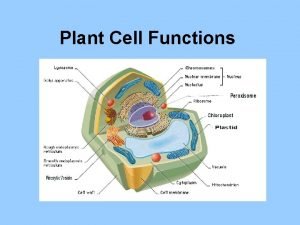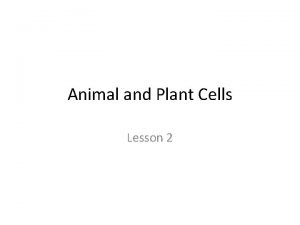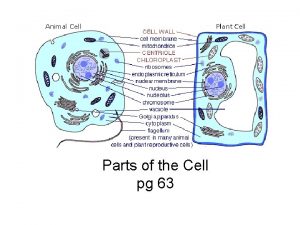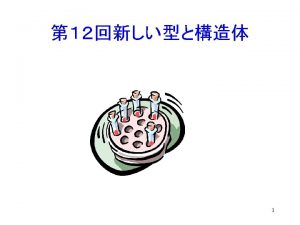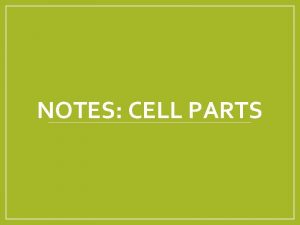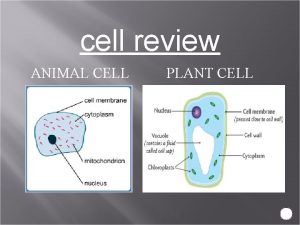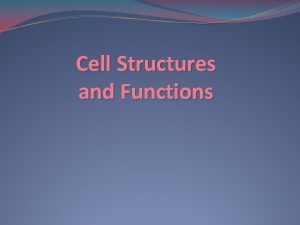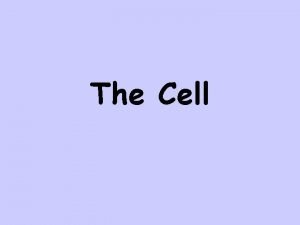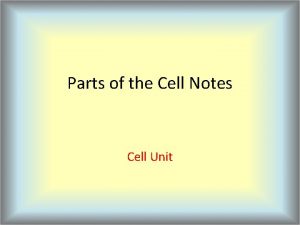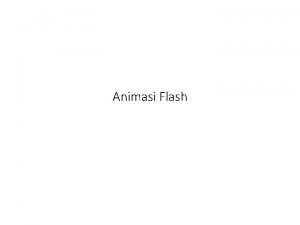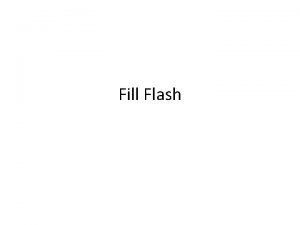Cell Parts and Functions Flash Card Notes Plant















- Slides: 15

Cell Parts and Functions Flash Card Notes

Plant Cell

Animal Cell

Cell Membrane n Structure: ¨ Phospholipid bilayer with proteins and carbohydrates ¨ Thin, flexible barrier ¨ Selectively Permeable n Functions ¨ Separates cell from surroundings ¨ Regulates molecules into/out of cell (food, water, wastes, etc. ) Found in all cells

Cell Wall n Structure: ¨ Made of cellulose (a carbohydrate) and proteins ¨ Rigid wall outside of cell membrane n Function: ¨ Support and protect ¨ Allows water, oxygen, carbon dioxide and other substances to pass through * Found only in plant, fungi, and algae cells, NOT in animals

Nucleus n Function: ¨ Stores DNA (chromatin), hereditary info for cell ¨ Controls cell activities n Components: ¨ Nuclear Envelope: bilayer lipid membrane that surrounds nucleus and has pores or holes to allow materials to move in/out of nucleus ¨ Nucleolus: Small dense region that makes ribosomes Found in plant and animal cells

Ribosomes ¨ Most n numerous cell part Structure: ¨ Made n of RNA and protein Function: ¨ Synthesis of Proteins (make proteins) Found in plant and animal cells

Rough and Smooth Endoplasmic Reticulum n Structure: ¨Internal membrane system ¨Stacks of flattened sacs n Rough: has ribosomes- gives a bumpy appearance n Smooth: no ribosomes- looks smooth

Rough and Smooth Endoplasmic Reticulum (contin. ) n Function: ¨ Intracellular highway—moves molecules around the cell Rough: chemically changes proteins made by ribosomes, sends proteins to Golgi for export n Smooth: synthesizes lipids and cell membrane parts, detox Found in plant and animal cells n

Golgi Apparatus n Structure: ¨ Stacks of flattened membranes n Function: ¨ Processing, packaging, and secreting proteins ¨ Attach carbs and lipids to proteins ¨ Send proteins to their final destinations Found in plant and animal cells

Lysosome n Structure: ¨ Small sac which contains hydrolytic enzymes ¨ Not in plants n Functions: ¨ Digest proteins, carbs, and lipids, DNA or RNA in cell ¨ Removes debris: digests old organelle or viruses and bacteria

Vacuole n Structure: ¨ Large sac filled with enzymes, water, and wastes ¨ In plants: VERY large – takes up most of cell ¨ In animals: small – store extra materials n Function: ¨ Storage n Vesicles: small vacuoles involved in transporting substances within cells

Chloroplast n Structure: ¨ Saclike structure that contains chlorophyll (a green pigment) n Function: ¨Photosynthesis: Changes sunlight energy to sugar n Found in plants, algae, and some bacteria n NOT found in animals

Mitochondria n Structure: ¨ Has n 2 membranes Function: ¨ “Cellular Respiration: releases energy from food molecules to power cell (growth, movement, development, etc. ) Found in plant and animal cells

Centrioles Structure: A pair of small organelles made of microtubuless n Function: Help in the formation of the spindle fibers used in cell division Only found in animal cells n
 What is the structure and function of the smooth er?
What is the structure and function of the smooth er? Digital photography with flash and no-flash image pairs
Digital photography with flash and no-flash image pairs Venn diagram plant vs animal cells
Venn diagram plant vs animal cells Plant cell structure
Plant cell structure Whats the difference between plant and animal cells
Whats the difference between plant and animal cells Idealized plant cell
Idealized plant cell Comparing plant and animal cells venn diagram
Comparing plant and animal cells venn diagram Flexible covering of an animal cell
Flexible covering of an animal cell What is the function of a cell
What is the function of a cell Plant parts name
Plant parts name Parts of the plants and their functions
Parts of the plants and their functions Ferns structure
Ferns structure 6 parts of a plant and their functions
6 parts of a plant and their functions Plant cell functions
Plant cell functions Plant cell functions
Plant cell functions Functions of endoplasmic reticulum
Functions of endoplasmic reticulum










